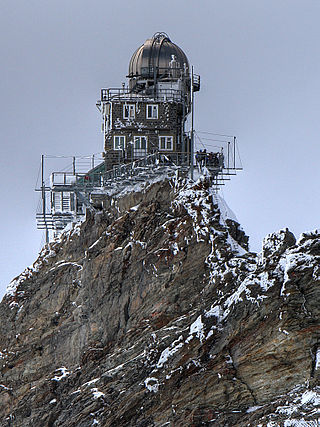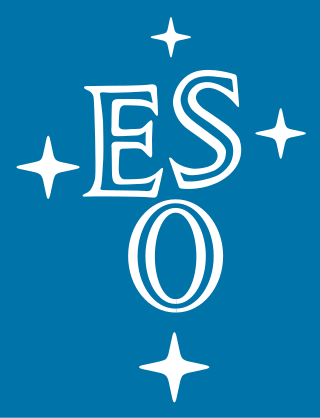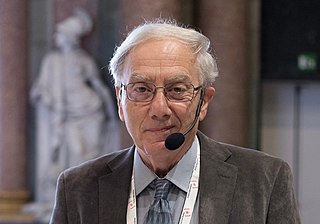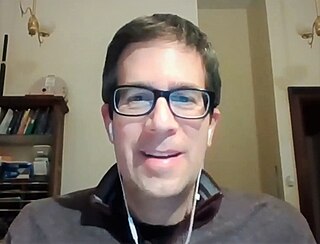
An observatory is a location used for observing terrestrial, marine, or celestial events. Astronomy, climatology/meteorology, geophysical, oceanography and volcanology are examples of disciplines for which observatories have been constructed. Historically, observatories were as simple as containing an astronomical sextant or Stonehenge.

Sandra Moore Faber is an American astrophysicist known for her research on the evolution of galaxies. She is the University Professor of Astronomy and Astrophysics at the University of California, Santa Cruz, and works at the Lick Observatory. She has made discoveries linking the brightness of galaxies to the speed of stars within them and was the co-discoverer of the Faber–Jackson relation. Faber was also instrumental in designing the Keck telescopes in Hawaii.

The European Organisation for Astronomical Research in the Southern Hemisphere, commonly referred to as the European Southern Observatory (ESO), is an intergovernmental research organisation made up of 16 member states for ground-based astronomy. Created in 1962, ESO has provided astronomers with state-of-the-art research facilities and access to the southern sky. The organisation employs about 730 staff members and receives annual member state contributions of approximately €162 million. Its observatories are located in northern Chile.

A refracting telescope is a type of optical telescope that uses a lens as its objective to form an image. The refracting telescope design was originally used in spyglasses and astronomical telescopes but is also used for long-focus camera lenses. Although large refracting telescopes were very popular in the second half of the 19th century, for most research purposes, the refracting telescope has been superseded by the reflecting telescope, which allows larger apertures. A refractor's magnification is calculated by dividing the focal length of the objective lens by that of the eyepiece.

The Atacama Large Millimeter/submillimeter Array (ALMA) is an astronomical interferometer of 66 radio telescopes in the Atacama Desert of northern Chile, which observe electromagnetic radiation at millimeter and submillimeter wavelengths. The array has been constructed on the 5,000 m (16,000 ft) elevation Chajnantor plateau - near the Llano de Chajnantor Observatory and the Atacama Pathfinder Experiment. This location was chosen for its high elevation and low humidity, factors which are crucial to reduce noise and decrease signal attenuation due to Earth's atmosphere. ALMA provides insight on star birth during the early Stelliferous era and detailed imaging of local star and planet formation.

The Chico Community Observatory, also known as the Anita Ingrao Observatory, is a non-profit astronomical observatory owned and operated by Kiwanis Club of Greater Chico. It is located in Chico, California's upper Bidwell Park. Entrance to the observatory is free as the facility operates on donations and volunteers.

Llano de Chajnantor Observatory is the name for a group of astronomical observatories located at an altitude of over 4,800 m (15,700 ft) in the Atacama Desert of northern Chile. The site is in the Antofagasta Region approximately 50 kilometres (31 mi) east of the town of San Pedro de Atacama. The exceptionally arid climate of the area is inhospitable to humans, but creates an excellent location for millimeter, submillimeter, and mid-infrared astronomy. This is because water vapour absorbs and attenuates submillimetre radiation. Llano de Chajnantor is home to the largest and most expensive astronomical telescope project in the world, the Atacama Large Millimeter Array (ALMA). Llano de Chajnantor and the surrounding area has been designated as the Chajnantor Science Reserve by the government of Chile.

Mario Livio is an Israeli-American astrophysicist and an author of works that popularize science and mathematics. For 24 years (1991-2015) he was an astrophysicist at the Space Telescope Science Institute, which operates the Hubble Space Telescope. He has published more than 400 scientific articles on topics including cosmology, supernova explosions, black holes, extrasolar planets, and the emergence of life in the universe. His book on the irrational number phi, The Golden Ratio: The Story of Phi, the World's Most Astonishing Number (2002), won the Peano Prize and the International Pythagoras Prize for popular books on mathematics.

The International Year of Astronomy (IYA2009) was a year-long celebration of astronomy that took place in 2009 to coincide with the 400th anniversary of the first recorded astronomical observations with a telescope by Galileo Galilei and the publication of Johannes Kepler's Astronomia nova in the 17th century. The Year was declared by the 62nd General Assembly of the United Nations. A global scheme, laid out by the International Astronomical Union (IAU), was also endorsed by UNESCO, the UN body responsible for educational, scientific, and cultural matters.

The NRC Herzberg Astronomy and Astrophysics Research Centre is the leading Canadian centre for astronomy and astrophysics. It is based in Victoria, British Columbia. The current Director-General, as of 2021, is Luc Simard.

A telescope is a device used to observe distant objects by their emission, absorption, or reflection of electromagnetic radiation. Originally meaning only an optical instrument using lenses, curved mirrors, or a combination of both to observe distant objects, the word telescope now refers to a wide range of instruments capable of detecting different regions of the electromagnetic spectrum, and in some cases other types of detectors.
Tod R. Lauer is an American astronomer on the research staff of the National Optical Astronomy Observatory. He was a member of the Hubble Space Telescope Wide Field and Planetary Camera team, and is a founding member of the Nuker Team. His research interests includes observational searches for massive black holes in the centers of galaxies, the structure of elliptical galaxies, stellar populations, large-scale structure of the universe, and astronomical image processing. He was the Principal Investigator of the Destiny JDEM concept study, one of the precursors to the Nancy Grace Roman Space Telescope mission. Asteroid 3135 Lauer is named for him. He appears in an episode of the documentary series Naked Science. He joined the New Horizons Pluto team in order to apply his extensive experience with deep space imaging to the New Horizons data, yielding significantly clearer and mathematically accurate images of Pluto and Charon.

The National Institute for Astrophysics is an Italian research institute in astronomy and astrophysics, founded in 1999. INAF funds and operates twenty separate research facilities, which in turn employ scientists, engineers and technical staff. The research they perform covers most areas of astronomy, ranging from planetary science to cosmology.

Amy Mainzer is an American astronomer, specializing in astrophysical instrumentation and infrared astronomy. She is the Deputy Project Scientist for the Wide-field Infrared Survey Explorer and the Principal Investigator for the NEOWISE project to study minor planets and the Near Earth Object Surveyor space telescope mission.

Rodger Evans Doxsey was an American physicist and astronomer who made major contributions to the scientific and operational success of NASA's Hubble Space Telescope (HST). He joined the HST Project at the Space Telescope Science Institute (STScI), in Baltimore, Maryland, in 1981, and was head of the Hubble Missions Office at his death.

The Astronomy and Astrophysics Decadal Survey is a review of astronomy and astrophysics literature produced approximately every ten years by the National Research Council of the National Academy of Sciences in the United States. The report surveys the current state of the field, identifies research priorities, and makes recommendations for the coming decade. The decadal survey represents the recommendations of the research community to governmental agencies on how to prioritize scientific funding within astronomy and astrophysics. The editing committee is informed by topical panels and subcommittees, dedicated conferences, and direct community input in the form of white papers summarizing the state of the art in each subdiscipline. The most recent report, Astro2020, was released in 2021.

Nostalgia for the Light is a 2010 documentary film by Patricio Guzmán to address the lasting impacts of Augusto Pinochet's dictatorship. Guzmán focuses on the similarities between astronomers researching humanity's past, in an astronomical sense, and the struggle of many Chilean women who still search, after decades, for the remains of their relatives executed during the dictatorship. Patricio Guzmán narrates the documentary himself and the documentary includes interviews and commentary from those affected and from astronomers and archeologists.
Christine D. Wilson is a Canadian-American physicist and astronomer, currently a University Distinguished Professor at McMaster University.
Kris Koenig is an American film producer, screenwriter, director and cinematographer known for his roles in the documentaries; 400 Years of the Telescope and Astronomy: Observations and Theories.

Dean Regas is an American astronomer, public speaker, author, and television host. He is most widely known as the cohost of the syndicated television show Star Gazers, which airs daily on more than 100 PBS stations around the world. He has been the Outreach Astronomer for the Cincinnati Observatory since 2000 where he specializes in astronomy education and public speaking. Regas is the author of three books Facts From Space!, 100 Things to See in the Night Sky, and 100 Things to See in the Southern Night Sky.


















